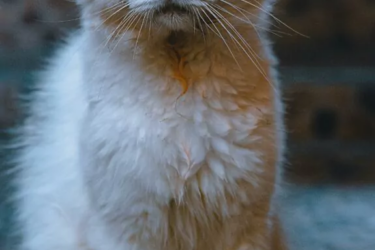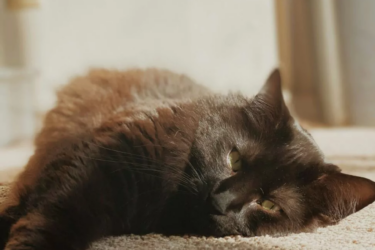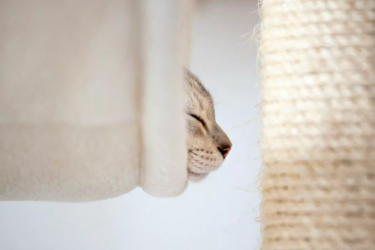
Eager to learn, talkative, and very affectionate. That’s the Burmese in a nutshell. Originally from the Far East, this cat actually enjoys being around anywhere, as long as there are loving people. Read all about this lovely cat breed here!
In this blog:
- Where does the Burmese cat come from?
- The personality of a Burmese
- What does a Burmese cat look like: appearance and coat
- The health of a Burmese
- How long does a Burmese live?
- Caring for a Burmese
- Buying a Burmese (kitten)

1. Where does the Burmese cat come from?
Burmese cats originally come from Burma – now called Myanmar. We know this, but not much is known about the breeding history of this beautiful breed. However, that’s not too important because we do know many other interesting things about these cats. For example, we know that Burmese cats were once temple cats. They were considered sacred cats and were revered by monks and wealthy (and very important) people.
Burmese cats remain active well into old age. Therefore, treat them to a nice cat tree for active cats!
Somewhere in the 1930s, a doctor brought a light brown Burmese cat to San Francisco in the United States. No one had ever seen such a breed before, so various scientists and breeders investigated the question: what kind of cat is this? Although the cat resembled a somewhat darker Siamese, it was still a different breed. The cat was crossed with a sealpoint Siamese. The son born from this union produced dark brown kittens, and these are the original ancestors of the Burmese cats as we know them today.
The Burmese cat was officially recognized as a breed by the Cat Fanciers’ Association in 1936. However, this recognition was withdrawn when some breeders began crossing the breed with Siamese cats. But thanks to a group of other breeders who kept the breed pure, the Burmese cat was officially recognized again in 1954. And the breed standards have not changed since then.

2. The Personality of the Burmese
Like any other Oriental breed, the Burmese is an incredible chatterbox. “Talkative” is high on the list of characteristics. But there’s more fun to share! Burmese cats are quite special. They bond strongly with their owners and are endlessly loyal. In addition, these cats are super intelligent, curious, agile, and active – and they remain so well into old age. They also love attention and aren’t shy about asking for it!
Because Burmese cats are so active, they are absolutely not suited to being indoor-only cats. These cats need challenges and space to move. If you’d like to have a cat of this breed, make sure you have a safe outdoor area where your cat can climb, play, and explore the surroundings. And not unimportantly: play with your cat at least three times a day, because that makes them very happy!
Good to know: the Burmese doesn’t like being alone and needs a companion. This breed is not suited to being the only cat in the house.

3. What Does a Burmese Cat Look Like: Appearance and Coat
Burmese cats are elegant and beautiful, with a truly Oriental look. They are medium-sized, have a muscular body, and a short tail. The eyes of a Burmese cat are round, large, and often yellow or golden in color. The head is wedge-shaped with full cheeks and a short muzzle. The legs are also slightly shorter than average.
Their coat is soft, short, and dense. It shines beautifully and can come in a variety of colors, such as blue, brown, chocolate, red, lilac, cream, and cinnamon. Silver and fawn were recently introduced and recognized in the breed. It is rare, but some Burmese cats also have a brown or chocolate tortie pattern.

4. The Health of a Burmese
Purebred cats are bred for unique traits. The Burmese also has characteristics that make it special, such as:
- Wedge-shaped head
- Muscular body
- Short muzzle
Do you think a Burmese cat is right for you? Then be sure to research the health of this breed thoroughly. Many purebred cats are prone to hereditary conditions. The Burmese, for example, has a high risk of developing Burmese head defect – frontonasal dysplasia (abnormal head shape) and Feline Infectious Peritonitis (FIP, a contagious inflammation of the peritoneum). It is important to be aware of these conditions.
If you want to bring a healthy cat into your home, it’s best to consult a veterinarian. You can also check the websites of Dier & Recht and the Dutch Food and Consumer Product Safety Authority for information on the breed’s health, whether it is permitted, and what rules apply to breeders.
Always buy a Burmese from a reliable breeder, preferably one who is a member of a breed association. This way, you can be sure the cat is healthy and well cared for. Also, ask the breeder for a health certificate or guarantee for extra peace of mind.
5. How Long Does a Burmese Live?
You may not think so after reading all the conditions mentioned above, but a Burmese cat can live quite a long life – up to 17 years. Of course, it’s important that the cat is well cared for and regularly checked by a veterinarian.
6. Caring for a Burmese
Burmese cats have almost no undercoat. Therefore, frequent combing or brushing is not necessary, as these cats rarely get mats. But that doesn’t mean they don’t enjoy being brushed! On the contrary, every cat, no matter the breed, enjoys at least a monthly brushing session. Playing and giving plenty of love and attention is also important for this breed. So, make sure to play with your cat regularly and provide a good cat tree where your cat can climb and scratch.
When you choose a cat as a pet, you must take good care of it. This includes going to the vet for a check-up at least once a year (and of course, visiting immediately if your cat is sick), offering a safe home, providing healthy food, and fresh water every day. And in addition, you should also ensure:
- Sufficient clean litter boxes
- High-quality litter
- Comfortable cat beds for sleeping
- Protection against fleas and other parasites
Discover here what the typical cost of caring for a cat is

7. Buying a Burmese
Do you want to buy a Burmese? Go to a recognized breeder, preferably one who is a member of a breed association. This way, you can be sure you’re getting a healthy, well-socialized cat that has been bred in a humane manner. Always ask for the papers, a health certificate, and check the kitten’s parents. Also, take a look at the living conditions: is it clean and homely, and are the parents present? That’s a good sign. Do not buy cats from platforms like Marktplaats, eBay, or from unethical breeders.
A Burmese from a good breeder typically costs around 950 euros. Are you looking for a cat but don’t necessarily need a purebred? Consider checking animal shelters or adoption agencies. Many lovely cats are waiting for a good home.
And remember: you don’t have a cat for just a short time, but for its entire life. Are you ready to take good care of the animal and set aside money for its care and vet visits? Then a Burmese could become your new best friend!
Discover which cat breeds are ideal for families with children
Disclaimer: Petrebels is not a veterinarian or behavior expert. All content, information, and tips in this blog are meant for inspiration and have an informational purpose. If your cat has issues or problems, and you are unsure about your cat’s health, always consult a veterinarian or behavior specialist.


